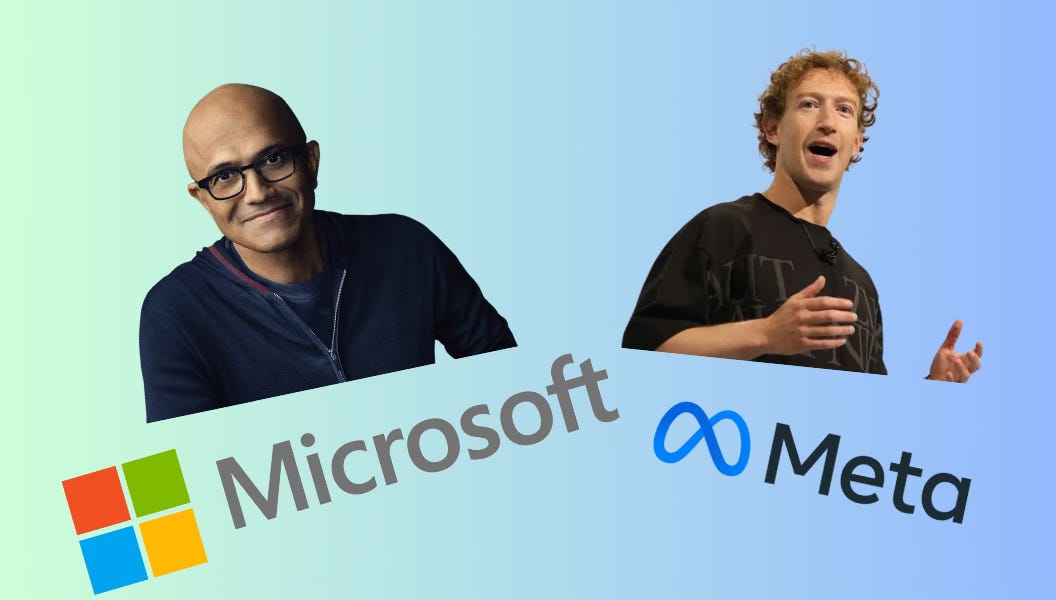AI’s Next Phase: What Meta and Microsoft’s CEOs Are Saying About DeepSeek
The AI world has been buzzing ever since DeepSeek’s breakthrough sent shockwaves through the market. Investors and industry leaders alike have been grappling with its implications — does this innovation mark a shift in AI’s resource needs, or is it simply another step in an ongoing evolution? Today, two of the most influential tech CEOs — Mark Zuckerberg of Meta and Satya Nadella of Microsoft—have weighed in. Their perspectives shed light on where AI infrastructure spending is headed and whether the industry’s biggest players still see value in scaling compute power.
Meta: DeepSeek Strengthens Our Strategy
On Meta’s Q4 earnings call, Zuckerberg addressed concerns about DeepSeek’s efficiency gains, making it clear that Meta isn’t backing away from its AI investment strategy. Instead, he emphasized that DeepSeek’s success has only validated Meta’s direction.
“There’s a number of novel things they did we’re still digesting,” he acknowledged, but assured investors that Meta plans to integrate DeepSeek’s advancements into its own AI models, including the upcoming Llama 4.
Zuckerberg also pushed back against fears that more efficient AI models will reduce the need for compute power. Instead, he argued that while training may become more optimized, inference — the process of running AI models in real-world applications — will require even greater computational resources.
“This doesn’t mean you need less compute,” he said. “You can apply more compute at inference time in order to generate a higher level of intelligence and a higher quality of service.”
Microsoft: AI Efficiency Has Always Been a Priority
Microsoft’s Satya Nadella echoed similar themes in his own earnings call, recognizing DeepSeek’s contributions while reaffirming Microsoft’s commitment to optimizing AI efficiency.
“DeepSeek has had some real innovations,” Nadella said, but he also noted that Microsoft and OpenAI have been working on cost and performance optimizations for years.
His comments were directed at a key question on investors’ minds: If AI models can be trained more efficiently, does that mean companies like Microsoft can scale back their infrastructure spending? Nadella’s answer was a firm no — Microsoft still plans to spend $80 billion on data centers this fiscal year to meet growing AI demand. However, he suggested that cost pressures will lead to more efficient resource allocation rather than reduced investment.
“We ourselves have been seeing significant efficiency gains both in training and inference for years now,” he said. “If it’s too expensive to serve, it’s no good, right?”
What This Means for AI Investment and Market Leadership
The reactions from Meta and Microsoft confirm a few critical takeaways:
AI efficiency is a priority, but compute demand isn’t going away. While DeepSeek’s breakthrough raises new questions about AI’s future infrastructure needs, both Zuckerberg and Nadella are betting that inference—where AI models are actually used — will continue to drive high compute requirements.
Market leaders will incorporate efficiency gains into their own models. Meta is already planning to adopt DeepSeek’s advancements into Llama 4, and Microsoft has been working on similar optimizations with OpenAI. This suggests that while DeepSeek was first to demonstrate these gains, it won’t be the only player benefiting from them.
The AI infrastructure race is far from over. Meta and Microsoft are reaffirming their commitment to scaling AI resources, which means the broader semiconductor and data center industries remain crucial to AI’s long-term trajectory.
Final Thoughts
DeepSeek’s impact continues to unfold, but if there’s one clear takeaway from these latest CEO comments, it’s this: AI isn’t just about training models more efficiently— it’s about making them more powerful in real-world use. The conversation is shifting toward inference efficiency, and the major tech players aren’t backing down from their investments in AI infrastructure.
At Triple Gains, we’ll continue tracking how these developments shape AI innovation, market leadership, and investment opportunities. Stay tuned for deeper insights into the evolving AI landscape.
What do you think? Will DeepSeek’s efficiency breakthroughs change the trajectory of AI infrastructure investment? Let us know in the comments!





